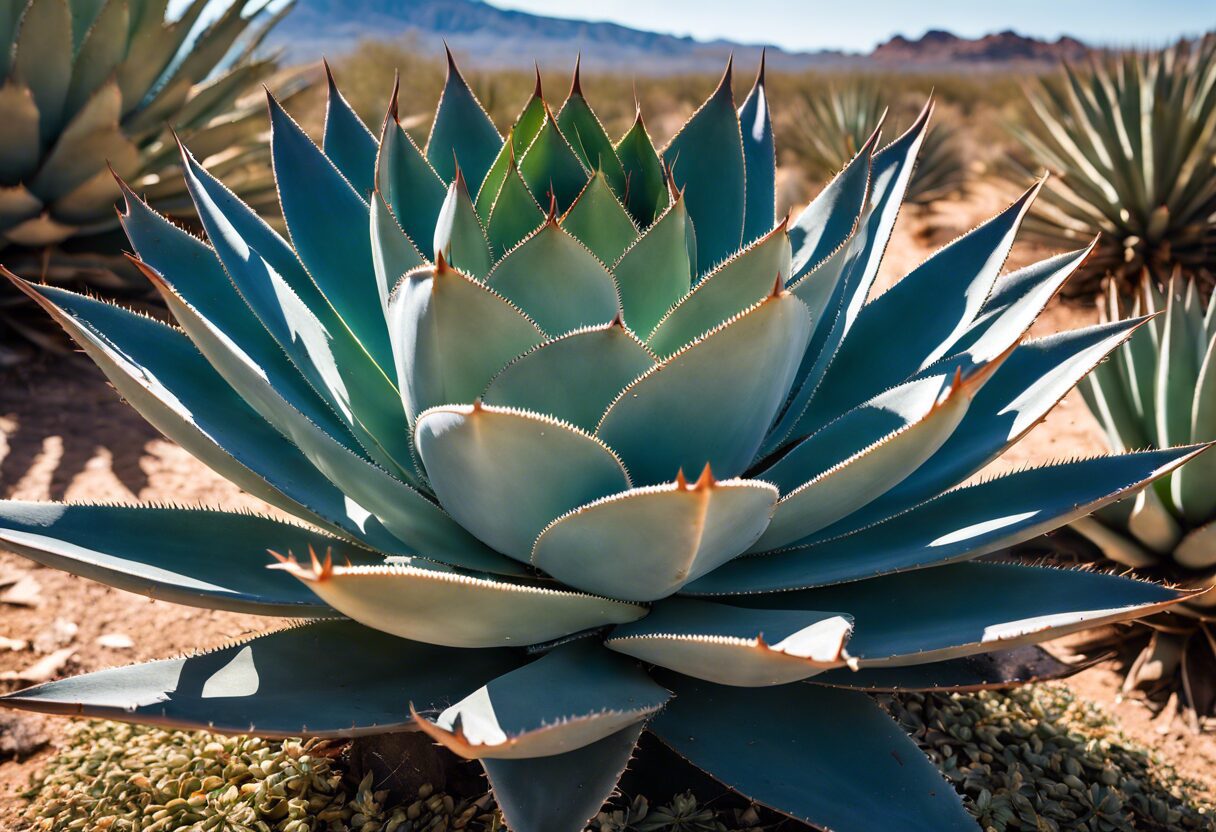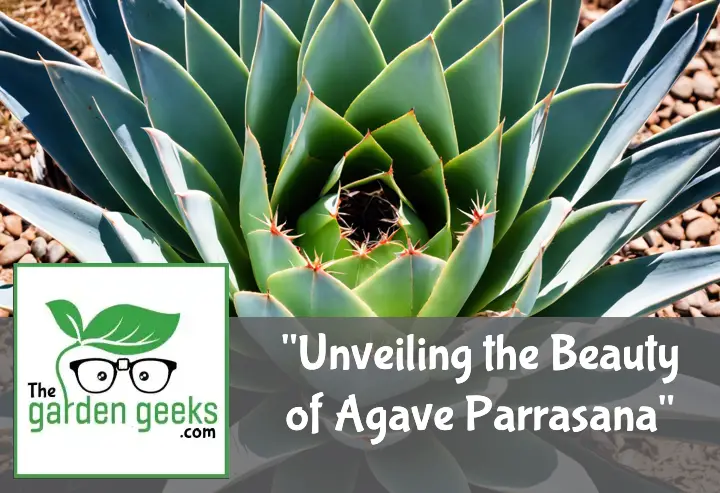Hello, plant enthusiasts! Today, we’re diving into the world of succulents to explore a unique gem – the Agave Parrasana. This beauty hails from Parras in Mexico and is a sight for sore eyes with its distinct rosette form.
In our next paragraphs, you’ll get to know this desert darling up close and personal. We’ll unveil its unique characteristics, ecological role, uses, and even some tips on how to grow it. So buckle up for an exciting journey into the world of Agave Parrasana. Keep reading about Unveiling the Beauty of Agave Parrasana!
Key Takeaways
- Agave Parrasana, also known as “Cabbage Head Agave,” is a beautiful succulent native to Mexico.
- It’s characterized by its rosette shape, blue-green leaves with red margins, and sharp spines.
- The plant is drought-tolerant and prefers full sun or light shade.
- It blooms once in its lifetime, producing a tall stalk with yellow flowers that attract pollinators.
- Agave Parrasana is often used in landscaping for its unique aesthetic appeal and low maintenance requirements.

What is Agave Parrasana?
Well, folks, let me introduce you to the Agave Parrasana. This beauty is a succulent plant that hails from the desert flora family. It’s one of those Mexican agave species that have managed to charm garden enthusiasts worldwide. A real showstopper in any ornamental garden!
Origin and Habitat
Now, where does this stunner come from? The native region of Agave Parrasana is Mexico, specifically the arid regions. It’s a tough cookie, adapting to various environments like a champ.
But don’t be fooled by its adaptability! The natural habitat conditions of this desert plant are quite harsh. Yet it thrives, showing off its survival skills in arid regions with ease.
And guess what? You can find these babies scattered across different geographical locations. Yes, the geographical distribution of Agave Parrasana is pretty impressive!
Physical Characteristics
Let’s talk looks now! The appearance of Agave Parrasana is nothing short of mesmerizing. Its leaves are a sight for sore eyes with their unique size and shape.
The color variations in this plant are another story altogether! From bluish-green to silvery-grey, the color variations in Agave Parrasana can leave you awestruck.
And did I mention its unique physical traits? Like most desert plants, it has some tricks up its sleeve to survive in harsh conditions. But we’ll save that for another day!
Why is Agave Parrasana Unique?


Let’s delve into the Agave Parrasana uniqueness. This plant has some distinctive features that make it stand out from other agaves. Its growth pattern, leaf formation, and special adaptations are all part of its charm.
Unique Growth Pattern
The Agave Parrasana growth pattern is a sight to behold. Unlike other agaves, this species doesn’t just grow upwards but also spreads outwards in a rosette pattern. It’s like watching a natural fireworks display in slow motion!
But wait, there’s more! The unique growth of Agave Parrasana isn’t just about aesthetics. This growth pattern helps the plant maximize sunlight absorption for photosynthesis.
Distinctive Leaf Formation
Now let’s talk about the distinctive leaf formation in Agave Parrasana. Each leaf is thick and fleshy with a spiky tip, giving it an almost prehistoric look. But don’t be fooled by their tough exterior; these leaves are as soft as marshmallows on the inside!
What makes these unique leaves of Agave Parrasana even more interesting is their coloration. They sport a beautiful blue-green hue that can turn purplish under stress conditions.
Special Adaptations
Finally, we can’t ignore the special adaptations of Agave Parrasana that allow it to thrive in harsh environments. For starters, its succulent leaves store water for dry periods – talk about being prepared!
Moreover, the plant has developed survival mechanisms like producing toxins to deter herbivores from munching on them. So next time you see an Agave Parrasana, remember – it’s not just another pretty face; it’s a survivor!



How Does Agave Parrasana Contribute to Ecosystem?
When it comes to ecological importance, the Agave Parrasana is a real MVP. This desert flora plays a crucial role in maintaining the ecological balance of its habitat.
Role in Desert Ecosystems
In the harsh conditions of desert ecosystems, this plant is like that friend who always brings snacks to a party. It’s adapted to survive through drought resistance and helps prevent soil erosion. Plus, it adds a sprinkle of biodiversity to the mix.
Interactions with Wildlife
Now, let’s talk about how Agave Parrasana interacts with wildlife. It’s like the popular kid in school – always surrounded by friends! It attracts pollinators and serves as a food source for local animals. And guess what? It also provides habitat for some critters. Talk about being multi-talented!
What are the Uses of Agave Parrasana?
Let’s dive into the fascinating world of Agave Parrasana uses, shall we? From traditional applications to modern uses, this plant has proven its worth time and again. The evolution of Agave Parrasana usage is a testament to its versatility.
Traditional Uses
Historically, Agave Parrasana was a big deal. It held cultural significance in many societies, with ancient practices involving this plant varying from one culture to another.
In some cultures, it was used for making pulque, a traditional alcoholic beverage. Others found it useful in crafting tools due to its sturdy nature. The benefits of Agave Parrasana were well recognized even back then!
Modern Applications
Fast forward to today, and you’ll find that the current use of Agave Parrasana has taken on a more scientific flair. Researchers are now exploring the plant’s potential in various fields.
For instance, some studies suggest it could be beneficial for soil conservation. Other research points towards its potential use in bioenergy production. The contemporary applications of this plant continue to expand as we learn more about it!
How to Cultivate and Care for Agave Parrasana?
When it comes to Agave Parrasana cultivation, there’s a bit of an art to it. But don’t worry, we’ve got you covered!
Ideal Growing Conditions
Agave Parrasana loves the sun! So, make sure it gets plenty of light. As for temperature, they’re pretty hardy and can handle a bit of cold. But try not to let them freeze! The best soil for Agave Parrasana? Well-drained stuff with a bit of grit.
Common Pests and Diseases
Now, onto the baddies. Pests affecting Agave Parrasana include mealybugs and scale insects. And as for diseases in Agave Parrasana plants, watch out for root rot! If your plant’s looking sickly, check its roots and make sure it’s not sitting in water.
Propagation Techniques
Finally, let’s talk about making more agaves! You can go the seed route if you’re patient or use offsets if you want instant gratification. Both methods work great when it comes to propagating agaves. Just remember: patience is key!


To Wrap Up
So, we’ve journeyed through the wild world of Agave Parrasana, a plant as intriguing and resilient as a secret agent in a spy thriller.
Remember, folks, just like any good movie plot, your garden story isn’t complete without a character as captivating and hardy as our friend Agave Parrasana. Let’s get planting!


